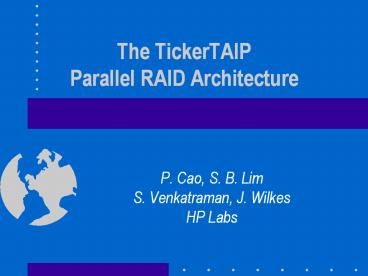The TickerTAIP Parallel RAID Architecture - PowerPoint PPT Presentation
Title:
The TickerTAIP Parallel RAID Architecture
Description:
Parity calculations are done in decentralized fashion: ... Design Issues (I) Normal-mode reads are trivial to implement. Normal mode writes: ... – PowerPoint PPT presentation
Number of Views:92
Avg rating:3.0/5.0
Title: The TickerTAIP Parallel RAID Architecture
1
The TickerTAIPParallel RAID Architecture
- P. Cao, S. B. LimS. Venkatraman, J. WilkesHP
Labs
2
RAID Architectures
- Traditional RAID architectures have
- A central RAID controller interfacing to the host
and processing all I/O requests - Disk drives organized in strings
- One disk controller per disk string (mostly SCSI)
3
Limitations
- Capabilities of RAID controller are crucial to
the performance of RAID - Can become memory-bound
- Presents a single point of failure
- Can become a bottleneck
- Having a spare controller is an expensive
proposition
4
Our Solution
- Have a cooperating set ofarray controller nodes
- Major benefits are
- Fault-tolerance
- Scalability
- Smooth incremental growth
- Flexibility can mix and match components
5
TickerTAIP
Hostinterconnects
Controller nodes
6
TickerTAIP ( I)
- A TickerTAIP array consists of
- Worker nodes connected with one or more local
disks through a bus - Originator nodes interfacing with host computer
clients - A high-performance small area network
- Mesh based switching network (Datamesh)
- PCI backplanes for small networks
7
TickerTAIP ( II)
- Can combine or separate worker and originator
nodes - Parity calculations are done in decentralized
fashion - Bottleneck is memory bandwidth not CPU speed
- Cheaper than having faster paths to a dedicated
parity engine
8
Design Issues (I)
- Normal-mode reads are trivial to implement
- Normal mode writes
- three ways to calculate the new parity
- full stripe calculate parity from new data
- small stripe requires at least four I/Os
- large stripe if we rewrite more than half a
stripe, we compute the parity by reading the
unmodified data blocks
9
Design Issues (II)
- Parity can be calculated
- At originator node
- Solely parity at the parity node for the stripe
- Must ship all involved blocks to party node
- At parity same as solely parity but partial
results for small stripe writes are computed at
worker node and shipped to parity node - Occasions less traffic than solely parity
10
Handling single failures (I)
- TickerTAIP must provide request atomicity
- Disk failures are treated as in standard RAID
- Worker failures
- Treated like disk failures
- Detected by time-outs(assuming fail-silent
nodes) - A distributed consensus algorithm reaches
consensus among remaining nodes
11
Handling single failures (II)
- Originator failures
- Worst case is failure of a originator/worker node
during a write - TickerTAIP uses a two-phase commit protocol
- Two options
- Late commit
- Early commit
12
Late commit/Early commit
- Late commit only commits after parity has been
computed - Only the writes must be performed
- Early commit commits as soon as new data and old
data have been replicated - Somewhat faster
- Harder to implement
13
Handling multiple failures
- Power failures during writes can corrupt stripe
being written - Use UPS to eliminate them
- Must guarantee that some specific requests will
always be executed in a given order - Cannot write data blocks before updating the
i-nodes containing block addresses - Uses request sequencing to achieve partial write
ordering
14
Request sequencing (I)
- Each request
- Is given a unique identifier
- Can specify one or more requests on whose
previous completion it depends(explicit
dependencies) - TickerTAIP adds enough implicit dependencies to
prevent concurrent execution of overlapping
requests
15
Request sequencing (II)
- Sequencing is performed by acentralized
sequencer - Several distributed solutions were considered but
not selected because of the complexity of the
recovery protocols they would require
16
Disk Scheduling
Not discussed in class in Fall 2005
- Considered
- First come first served (FCFS) implemented in
the working prototype - Shortest seek time first (SSTF)
- Shortest access time first (SATF)Considers both
seek time and rotation time - Batched nearest neighbor (BNN)Runs SATF on all
reuests in queue
17
Evaluation (I)
- Based upon
- Working prototype
- Used seven relatively slow Parsytec cards each
with its own disk drive - Event-driven simulator was used to test other
configurations - Results were always within 6 of prototype
measurements
18
Evaluation (II)
- Read performance
- 1MB/s links are enough unless the request sizes
exceed 1MB
19
Evaluation (III)
- Write performance
- Large stripe policy always results in aslight
improvement - At-parity significantly better than at-originator
especially for link speeds below 10MB/s - Late commit protocol reduces throughput by at
most 2 but can increase response time by up
to 20 - Early commit protocol is not much better
- TickerTAIP always outperforms a comparable
centralized RAID architecture - best disk scheduling policy is Batched Nearest
Neighbor
20
Evaluation (IV)
- TickerTAIP always outperforms a comparable
centralized RAID architecture - Best disk scheduling policy is Batched Nearest
Neighbor (BNN)
21
Conclusion
- Can use physical redundancy to eliminate single
points of failure - Can use eleven 5 MIPS processors instead of
single 50 MIPS - Can use off-the-shelf processors for parity
computations - Disk drives remain the bottleneck for small
request sizes

